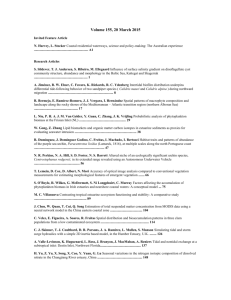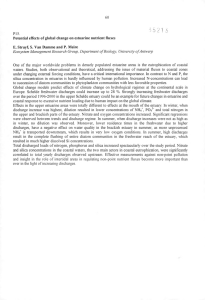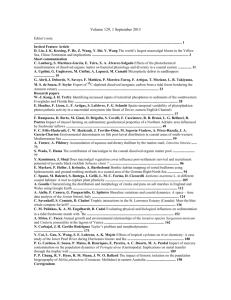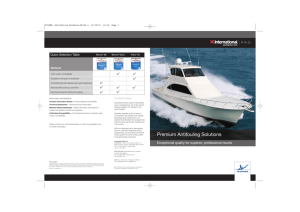Pollution_Contaminan..
advertisement
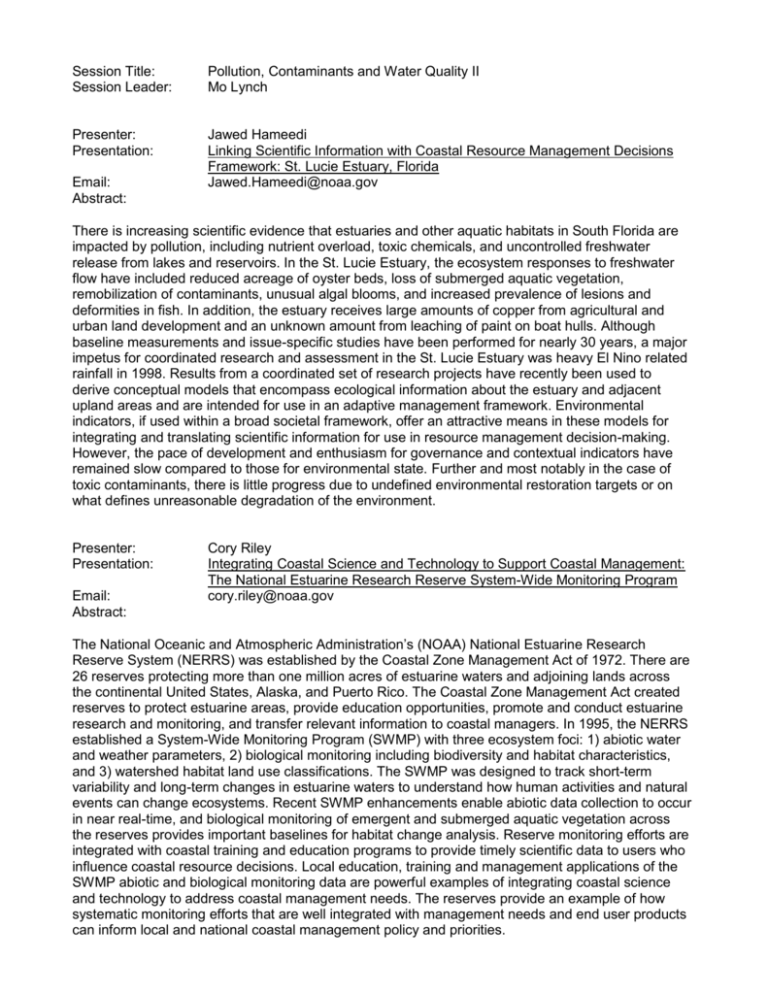
Session Title: Session Leader: Pollution, Contaminants and Water Quality II Mo Lynch Presenter: Presentation: Jawed Hameedi Linking Scientific Information with Coastal Resource Management Decisions Framework: St. Lucie Estuary, Florida Jawed.Hameedi@noaa.gov Email: Abstract: There is increasing scientific evidence that estuaries and other aquatic habitats in South Florida are impacted by pollution, including nutrient overload, toxic chemicals, and uncontrolled freshwater release from lakes and reservoirs. In the St. Lucie Estuary, the ecosystem responses to freshwater flow have included reduced acreage of oyster beds, loss of submerged aquatic vegetation, remobilization of contaminants, unusual algal blooms, and increased prevalence of lesions and deformities in fish. In addition, the estuary receives large amounts of copper from agricultural and urban land development and an unknown amount from leaching of paint on boat hulls. Although baseline measurements and issue-specific studies have been performed for nearly 30 years, a major impetus for coordinated research and assessment in the St. Lucie Estuary was heavy El Nino related rainfall in 1998. Results from a coordinated set of research projects have recently been used to derive conceptual models that encompass ecological information about the estuary and adjacent upland areas and are intended for use in an adaptive management framework. Environmental indicators, if used within a broad societal framework, offer an attractive means in these models for integrating and translating scientific information for use in resource management decision-making. However, the pace of development and enthusiasm for governance and contextual indicators have remained slow compared to those for environmental state. Further and most notably in the case of toxic contaminants, there is little progress due to undefined environmental restoration targets or on what defines unreasonable degradation of the environment. Presenter: Presentation: Email: Abstract: Cory Riley Integrating Coastal Science and Technology to Support Coastal Management: The National Estuarine Research Reserve System-Wide Monitoring Program cory.riley@noaa.gov The National Oceanic and Atmospheric Administration’s (NOAA) National Estuarine Research Reserve System (NERRS) was established by the Coastal Zone Management Act of 1972. There are 26 reserves protecting more than one million acres of estuarine waters and adjoining lands across the continental United States, Alaska, and Puerto Rico. The Coastal Zone Management Act created reserves to protect estuarine areas, provide education opportunities, promote and conduct estuarine research and monitoring, and transfer relevant information to coastal managers. In 1995, the NERRS established a System-Wide Monitoring Program (SWMP) with three ecosystem foci: 1) abiotic water and weather parameters, 2) biological monitoring including biodiversity and habitat characteristics, and 3) watershed habitat land use classifications. The SWMP was designed to track short-term variability and long-term changes in estuarine waters to understand how human activities and natural events can change ecosystems. Recent SWMP enhancements enable abiotic data collection to occur in near real-time, and biological monitoring of emergent and submerged aquatic vegetation across the reserves provides important baselines for habitat change analysis. Reserve monitoring efforts are integrated with coastal training and education programs to provide timely scientific data to users who influence coastal resource decisions. Local education, training and management applications of the SWMP abiotic and biological monitoring data are powerful examples of integrating coastal science and technology to address coastal management needs. The reserves provide an example of how systematic monitoring efforts that are well integrated with management needs and end user products can inform local and national coastal management policy and priorities. Presenter: Presentation: Email: Abstract: Leigh Johnson Integrating Science in Invasive Species and Water Quality Policies ltjohnson@ucdavis.edu California and the U.S. EPA are reevaluating antifouling paint registration and water-quality standards for dissolved copper. Research shows hull-borne aquatic invasive species tolerate copper better than native species, giving them a competitive edge in harbors polluted by copper. Recent water-quality regulations require San Diego Bay boat owners to reduce copper discharges from antifouling paints, and if similar antifouling paint restrictions are adopted elsewhere, nontoxic and less-toxic hull coatings will become more common. However, such coatings require companion strategies to control fouling growth, and while the National Aquatic Invasive Species (NAIS) Act of 2005 prescribes antifouling paints to control AIS, nontoxic hull coatings simply slow fouling growth rather than preventing it. The NAIS Act discourages in-water hull cleaning, yet frequent cleaning is needed to manage fouling growth on nontoxic hull coatings. (In San Diego, hauling and cleaning is nine times more expensive than in-water hull cleaning.) The authors prepared a white paper and policy analysis to assist decision makers, scientists and stakeholders in developing research, education and sustainable policies for controlling AIS while reducing antifouling paint pollution.
